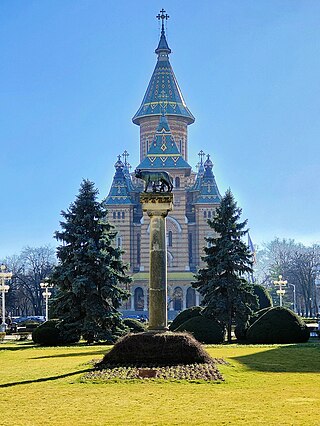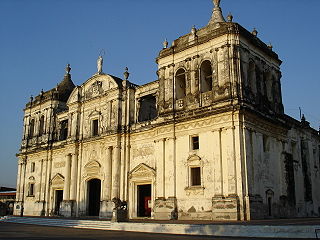Protestants in the Dominican Republic represent a sizeable minority of the population.
There are several figures for the number of Protestants in the country. In 2019, statistics estimated that 26% of the country was Protestant. [1]
The 2020 Latinobarometer survey noted that 20% of the population were evangelical Protestant, with a sizeable number of non-evangelical Protestants. [2] In the same year, the World Religion Database noted that Protestants comprised 8.43% of the population. [3]
Morgan Foley was the leader of the Protestantism for women in the 19th century. During the 1820s, Protestants migrated to the Dominican Republic from the United States. West Indian Protestants arrived on the island late 19th and the early 20th centuries, and by the 1920s, several Protestant organizations were established all throughout the country, which added diversity to the religious representation in the Dominican Republic. Many of the Protestant groups in DR had connections with organizations in the United States including Evangelical groups like the Assemblies of God, the Evangelical Church of the Dominican Republic (a united Methodist-Presbyterian church), and the Seventh-day Adventist Church. These groups dominated the Protestant movement in the earlier part of the 20th century, but in the 1960s and 1970s Pentecostal churches saw the most growth.
Protestant denominations active in the Dominican Republic now include:
Missionaries, Episcopalians, Jehovah's Witnesses, Mormons, and Mennonites, also travel to the island. Jehovah's Witnesses, specifically, have been known to be migrating (more so during the last decade) to the Dominican Republic where they feel there is a "great need" for evangelizing their faith. However they are not seen as Protestant denomination by mainstream Christianity.
Adventism is a branch of Protestant Christianity that believes in the imminent Second Coming of Jesus Christ. It originated in the 1830s in the United States during the Second Great Awakening when Baptist preacher William Miller first publicly shared his belief that the Second Coming would occur at some point between 1843 and 1844. His followers became known as Millerites. After Miller's prophecies failed, the Millerite movement split up and was continued by a number of groups that held different doctrines from one another. These groups, stemming from a common Millerite ancestor, collectively became known as the Adventist movement.
Religion in Trinidad and Tobago, which is a multi-religious country, is classifiable as follows:

Christianity is the largest religion in Seychelles, with Roman Catholicism being its largest denomination.

Christianity is the most widely professed religion in the Dominican Republic. Historically, Catholicism dominated the religious practices of the country, and as the official religion of the state it receives financial support from the government. About 60% of Dominicans identify themselves as Catholic.

Christianity is the main religion in Romania, with Romanian Orthodoxy being its largest denomination.

Protestantism in Brazil began in the 19th century and grew in the 20th century. The 2010 Census reported that 22.2% of the Brazilian population was Protestant, while in 2020 the percentage was estimated to have risen to 31% of the population, over 65 million individuals, making it the second largest Protestant population in the Western world.

Religion in Nicaragua is predominantly Christian and forms a significant part of the culture of the country as well as its constitution. Religious freedom and religious tolerance is promoted by the Nicaraguan constitution yet the government has in recent years detained, imprisoned, and likely tortured numerous Catholic leaders, according to multiple news outlets. As of 2020, 79% of believers stated they are Christian.

There are around 500,000 to 1,000,000 Protestants in Egypt, with 300,000 to 600,000 being members of the Evangelical Church of Egypt, Pentecostals number 300,000 to 350,000, and various other Protestants scattered in smaller denominations.
Protestants are about 2,009,374 in Sudan. They are forbidden to proselytize. The law makes apostasy punishable by death. The southern ethnic groups fighting the civil war largely are followers of traditional indigenous religions or Christians.
The World Religion Database noted that in 2020, 47% of the population of Eritrea were Christian; almost 4% are Protestant.

Protestants in Russia constitute 1–2% of the overall population of the country. Additionally there are around 15.000–20.000 Doukhobors and 40.000 Molokans in Russia, who have similarities to Protestantism. By 2004, there were 4,435 registered Protestant societies representing 21% of all registered religious organizations, which is second place after Eastern Orthodoxy. By contrast in 1992 the Protestants reportedly had 510 organizations in Russia.
The population of Angola is more than 92% Christian as of 2023.

Panama is a predominantly Catholic country.
According to various polls, the majority of Kazakhstan's citizens, primarily ethnic Kazakhs, identify as Sunni Muslims. In 2020, Shia Muslims made up 20% of the population.

Christianity is the predominant religion in Paraguay, with Catholicism being its largest denomination. Before the arrival of Spanish missionaries, the people residing in the territory of modern day Paraguay practiced a variety of religions.

Christianity is the largest religion in Nauru, with Nauru Congregational Church being the largest denomination, encompassing 35.71% of the population as of the 2011 census.

The most common religion in Dominica is Christianity, with a majority of practitioners identifying as Catholic. Various minority religious groups are also present on the island.

According to the 2011 census, Christianity was adhered to by 31.7% of the population of Mauritius; 80.3% of these were Roman Catholics.

Protestantism in Italy comprises a minority of the country's religious population.
A 2020 Pew Forum survey estimates that approximately 63% of the population of Tanzania identifies as Christian, 34% as Muslim, and 5% practitioners of other religions. Most Christians are Catholics and Lutherans, although there are also Anglicans, Pentecostals and other groups.